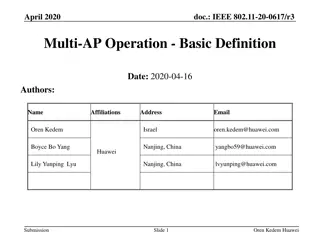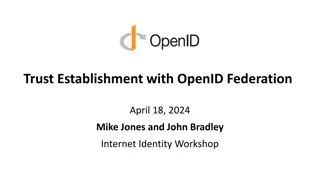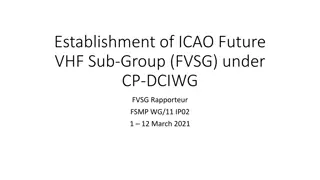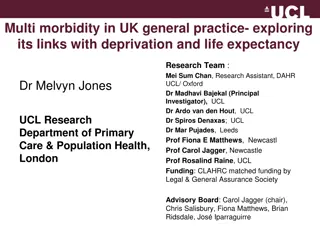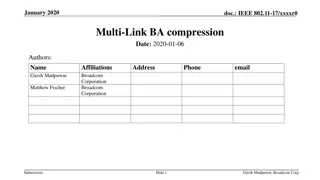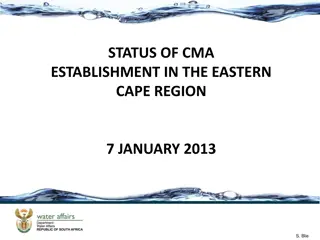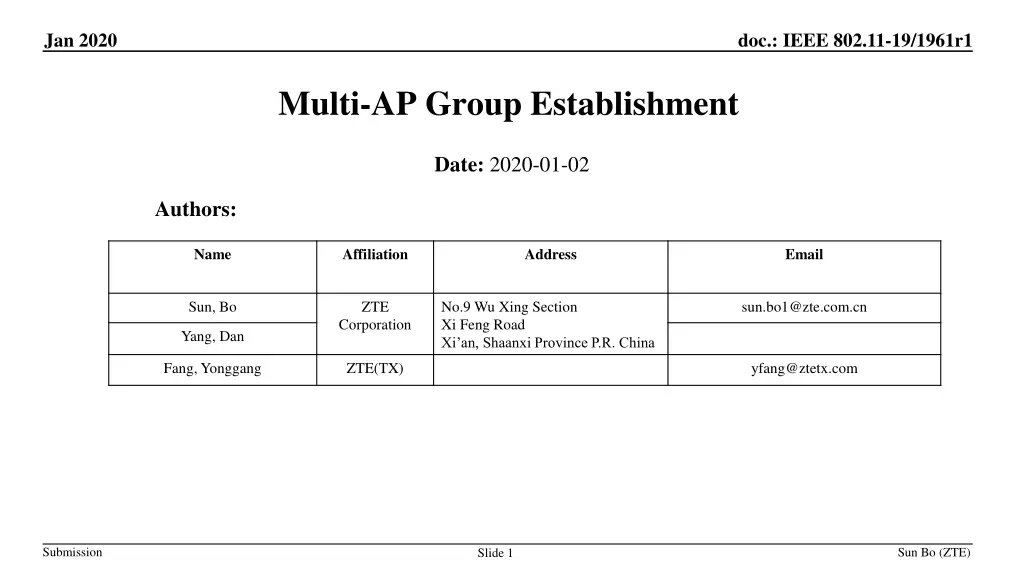
IEEE 802.11-19/1961r1: Multi-AP Group Establishment in Wireless Networks
Explore the establishment of multi-AP groups in IEEE 802.11-19/1961r1 standard for enhanced wireless network performance. Learn about static and dynamic multi-AP groups, their configurations, and implications for coordinated transmissions. Discover the concept, benefits, and strategies involved in forming these groups for efficient multi-AP transmissions.
Download Presentation

Please find below an Image/Link to download the presentation.
The content on the website is provided AS IS for your information and personal use only. It may not be sold, licensed, or shared on other websites without obtaining consent from the author. If you encounter any issues during the download, it is possible that the publisher has removed the file from their server.
You are allowed to download the files provided on this website for personal or commercial use, subject to the condition that they are used lawfully. All files are the property of their respective owners.
The content on the website is provided AS IS for your information and personal use only. It may not be sold, licensed, or shared on other websites without obtaining consent from the author.
E N D
Presentation Transcript
Jan 2020 doc.: IEEE 802.11-19/1961r1 Multi-AP Group Establishment Date: 2020-01-02 Authors: Name Affiliation Address Email Sun, Bo ZTE No.9 Wu Xing Section Xi Feng Road Xi an, Shaanxi Province P.R. China sun.bo1@zte.com.cn Corporation Yang, Dan Fang, Yonggang ZTE(TX) yfang@ztetx.com Submission Sun Bo (ZTE) Slide 1
Jan 2020 doc.: IEEE 802.11-19/1961r1 Introduction Multi-AP as one of the EHT key features has been discussed in several contributions [1][2][3]. In IEEE 802.11 September meeting, we presented a basic multi-AP transmission procedure for EHT [4], generally including: Under multi-AP scenarios, a group of APs connected via wired or wireless backhaul links is called a multi-AP network or a multi-AP group. In a preparation stage prior to multi-AP transmission, it suggested the STA may propose to its associated AP a set of recommended neighbour APs to participate following Multi-AP joint/coordinated transmissions. A Straw Poll of proposing STA to recommend candidate APs participating in multi-AP transmission was run. (Result: Yes: 14 / No: 1 / Abstain: 48). In this contribution, we further discuss the establishment of a multi-AP group for a multi-AP transmission during the preparation stage . Submission Sun Bo (ZTE) Slide 2
Jan 2020 doc.: IEEE 802.11-19/1961r1 Multi-AP group conception (1/2) The conception of static multi-AP group and dynamic multi-AP group: Static multi-AP group A static multi-AP group is a set of APs that any two or more APs of the group can potentially perform multi-AP transmissions, e.g. DL joint-transmissions, coordinated OFDMA transmissions, etc. The APs in the static multi-AP group are connected via wired or wireless backhaul link with or withour a central AP.The conception of static multi-AP group may apply to typical managed network scenarios, such as enterprise network, home network and commercial network. Each member of the static multi-AP group should announce the static multi-AP group information in its own BSS. Dynamic multi-AP group A dynamic multi-AP group is a set of APs that will participate in the following multi-AP transmissions. APs in the dynamic multi-AP group should be a subset of the static multi-AP. An AP in the static multi-AP group may belong to different dynamic multi-AP groups. Submission Sun Bo (ZTE) Slide 3
Jan 2020 doc.: IEEE 802.11-19/1961r1 Multi-AP group conception (2/2) Two examples about static and dynamic multi-AP group in joint/coordinated transmissions are illustrated as Fig. 1 and Fig. 2 . Fig. 1 Fig. 2 Submission Sun Bo (ZTE) Slide 4
Jan 2020 doc.: IEEE 802.11-19/1961r1 Dynamic Multi-AP Group Discussion A dynamic multi-AP group could maintain for several multi-AP transmssions. However, the distribution strategy of buffered data or members' availability, etc., may change dynamically prior to the multi-AP transmission, especially for a mobile STA. Thus the participants of the dyanmic multi-AP group for a STA may be reselected before multi-AP transmission by the associated AP. An example of dynamic multi-AP group is illustrated in Fig. 3. AP2 1. (AP1, AP2) perform a dynamic multi-AP group for DL joint-transmission to STA1. STA1 moves to a new position and recommends (AP2, AP3) for the next DL joint-transmission. (AP2,AP3) then form a new dynamic multi-AP group to perform the following DL joint- transmission to STA1. dynamic group 1 AP3 2. AP1 dynamic group 2 3. joint transmission 1 joint transmission 2 STA1 mobility STA1 Fig. 3 Submission Sun Bo (ZTE) Slide 5
Jan 2020 doc.: IEEE 802.11-19/1961r1 Dynamic Multi-AP Group Establisment A STA recommends the candidate APs for its dynamic multi-AP group. In many cases, members of static or dynamic multi-AP group may not be able to hear each other over the air, as illustrated in Fig. 4. Thus the associated AP can hardly decide the best candidates in the dynamic mutli-AP group for a STA,especially in a dynamic radio environment, without prompt measurement reports from the STA. The STA has the up-to-date knowledge of radio environments for a DL transmission, e.g. APs' singal strength, and knows better which APs' transmission will interfere with its reception, etc.. The associated AP may use the recommendation from the STA to establish a dynamic multi-AP group for the multi-AP transmission. STAs may need a confirmation from the associated AP about the member of the dynamic multi-AP group. Static Multi-AP Group 1. 2. (AP1,AP2,AP3) are in a static multi-AP group. (AP1, AP2) can not hear each other, (AP2, AP3) can not hear each other either. (AP1,AP2, AP3) form a dynamic multi-AP group and perform a joint transmission to STA1. AP2 AP1 STA1 3. AP3 Fig. 4 Submission Sun Bo (ZTE) Slide 6
Jan 2020 doc.: IEEE 802.11-19/1961r1 Summary Multi-AP group related conceptions are proposed: static multi-AP group and dynamic multi-AP group. The establishment of a dynamic multi-AP group is discussed. Further study may include Multi-AP group establishment optimization Multi-AP transmission procedure optimization Submission Sun Bo (ZTE) Slide 7
Jan 2020 doc.: IEEE 802.11-19/1961r1 Straw Poll 1 Do you support that the AP should deliver the information of the static multi-AP group within the BSS ? A static multi-AP group is a set of APs connected with backhaul in which any two or more members can potentially perform multi-AP transmissions. Submission Sun Bo (ZTE) Slide 8
Jan 2020 doc.: IEEE 802.11-19/1961r1 Straw Poll 2 Do you support that a STA may recommend candidate APs for a dynamic multi- AP group ? The associated AP may use the recommendation from the STA to establish and trigger a dynamic multi-AP group formation for multi-AP transmissions. Submission Sun Bo (ZTE) Slide 9
Jan 2020 doc.: IEEE 802.11-19/1961r1 Straw Poll 3 Do you support that an AP should deliver the information of dynamic multi-AP group to its associating STA(s)? A dynamic multi-AP group is a set of APs that will participate in the future multi-AP transmissions. Submission Sun Bo (ZTE) Slide 10
Jan 2020 doc.: IEEE 802.11-19/1961r1 References [1] 11-18-1509-00-0eht-features-for-multi-ap-coordination [2] 11-18-1926-00-0eht-terminology-for-ap-coordination [3] 11-18-1982-01-0eht-consideration-on-multi-ap-coordination-for-eht [4] 11-19-1129-02-00be-consideration-on-multi-ap-coordination Submission Sun Bo (ZTE) Slide 11

